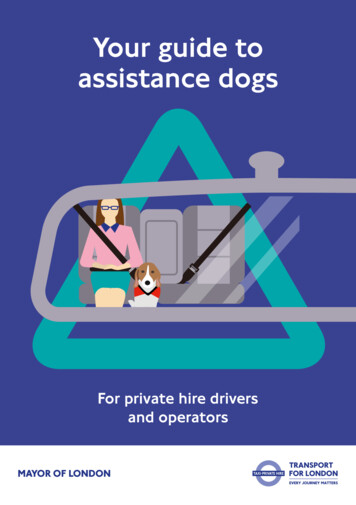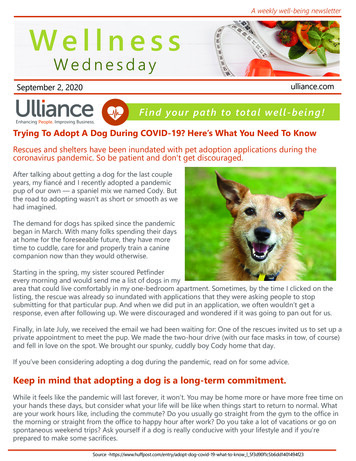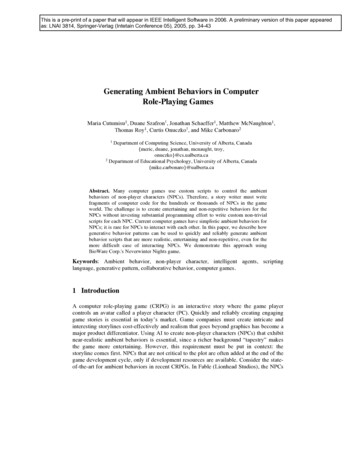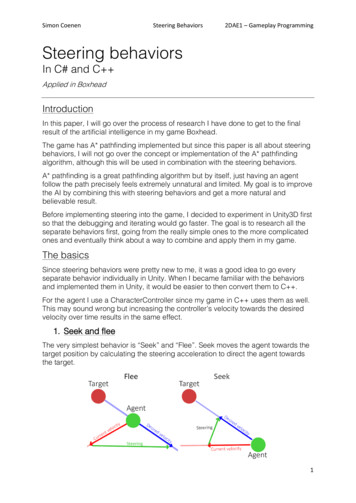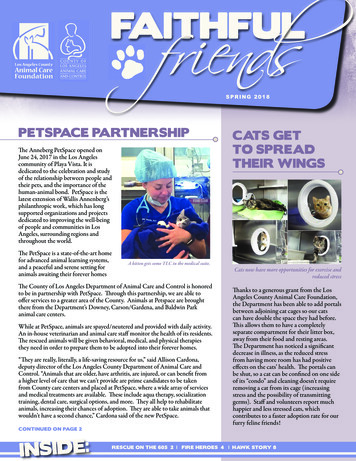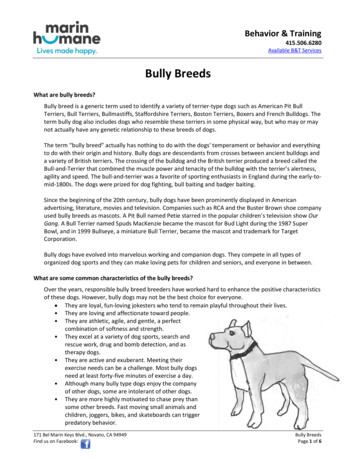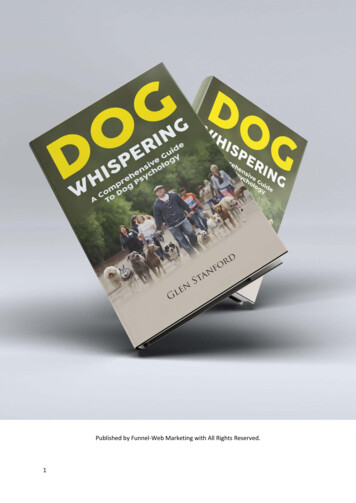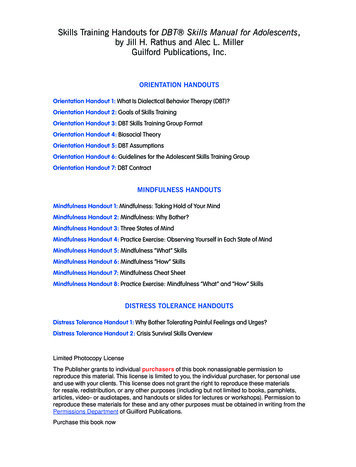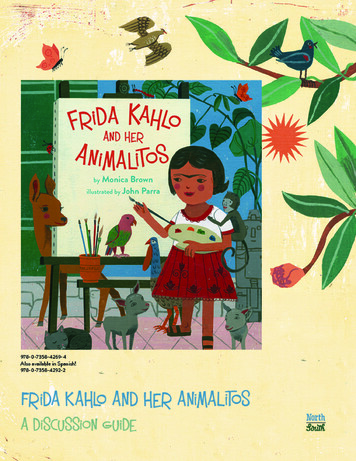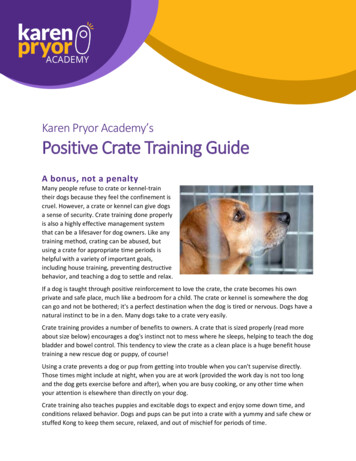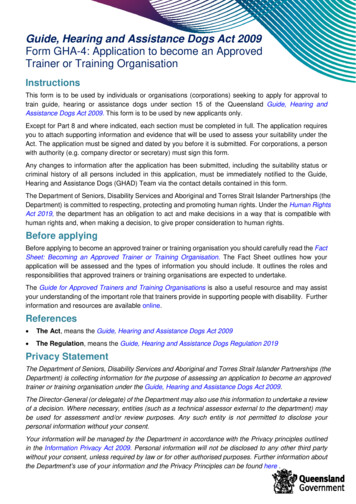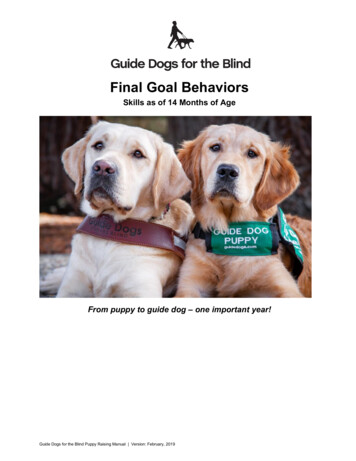
Transcription
Final Goal BehaviorsSkills as of 14 Months of AgeFrom puppy to guide dog – one important year!Guide Dogs for the Blind Puppy Raising Manual Version: February, 2019
Guide dogs work in real-life environments that constantly present demanding and stimulating situations. Aguide dog puppy needs to develop skills that support its intended future work as a guide dog and lifecompanion to a partner who is blind or visually impaired. The puppy raiser has the challenging task ofdeveloping a young puppy into a mannerly young adult dog that is prepared for formal guide dog training andcan be readily managed by a handler who is blind.TRAINED BEHAVIORS AND CUED RESPONSESIt is important for the adult guide dog to respond to cued behaviors in a variety of environments andsituations. Puppies need to be prepared to perform basic management behaviors for a handler who is blind, ina variety of circumstances. It is desirable that goal behaviors can be performed in real-world situations.Guide Dogs for the Blind Puppy Raising Manual Version: April, 2019
AUDIBLE MARKER RESPONSE – “NICE” (MARKS DESIRED BEHAVIOR)Ideal: Dog immediately reacts to hearing the verbal marker “Nice” with animated anticipation of food reward.While showing excitement, the dog is able to maintain its current position (at the time of the mark) anticipatingdirect food reward delivery from the handler.Acceptable: Dog immediately reacts to hearing the verbal marker “Nice” with animated anticipation of foodreward. Some movement towards the food reward delivery may be present yet the dog remains mannerlyduring the delivery.Not Ready for Recall: Dog does not react upon hearing the verbal marker “Nice” (no obvious change indemeanor) or becomes assertive getting to the food reward (e.g. moving to the food reward supply,significantly out of position).FOOD REWARD ACCEPTANCEIdeal: Dog demonstrates eagerness for dry kibble food reward (its regular diet) while maintaining a gentlemanner of taking food from the hand. Handler feels no discomfort when delivering food reward directly to thedog’s mouth.Acceptable: Dog demonstrates enjoyment of dry kibble food reward (its regular diet). Dog may require aspecific method of delivery for handler comfort (e.g. cupped hand delivery) but presents no discomfort tohandler during food delivery.Not Ready for Recall: Dog shows little enjoyment over dry kibble food reward and requires higher value foodrewards to spark enthusiasm. Dog is rough in its manner of taking food reward from the hand, causinghandler discomfort.Guide Dogs for the Blind Puppy Raising Manual Version: April, 2019
ENJOYMENT OF SECONDARY REINFORCEMENTIdeal: Dog demonstrates enjoyment of, and the desire to receive, affection via verbal praise and physicaltouch. Physical and verbal rewards are clearly rewarding to the dog, acting as effective reinforcement fordesired behavior.Acceptable: Dog demonstrates enjoyment and acceptance of affection via verbal praise and physical touch.Physical and verbal rewards are pleasing to the dog, helping to maintain established desired behaviors.Not Ready for Recall: Dog shows little emotional change during verbal and/or physical affection from thehandler. Undesirable responses to verbal and/or physical praise include: low interest in relating to handler,indifference towards affection, and avoidance of physical touch.ENVIRONMENTAL FOOD AND DEBRIS AVOIDANCEIdeal: Dog seeks food reward via handler delivery only. Dog will by-pass available food or debris in theenvironment, confidently choosing to disregard accessible oral temptations. This includes disregarding foodrewards dropped by the handler.Acceptable: Dog regularly demonstrates the ability to by-pass available food or debris in the environment,confidently choosing to leave accessible oral temptations alone. Dog may require occasionally handling toprevent transgressions in more tempting circumstances. Dog is able to disregard food rewards dropped bythe handler.Not Ready for Recall: Dog does not demonstrate the ability to frequently by-pass available food or debris inthe environment, frequently or obsessively picking up/eating environmental food or debris. Dog actsimpulsively upon opportunities to take food or debris in the environment.Guide Dogs for the Blind Puppy Raising Manual Version: April, 2019
“SIT” / “STAND” / “DOWN”Ideal: The puppy performs behaviors of Sit, Stand, and Down upon the verbal cues, while remaining in place.Acceptable: With lack of response to the verbal cue, the puppy performs the behavior with the addition of ahand-signal or upon a minimal leash cue while remaining in place. May have minor movement out of positionwhen performing the behavior.Not Ready for Recall: Puppy shows partial or no response to verbal/signal and/or leash cues. Undesirableresponses include not remaining in place or changing to another behavior immediately after responding to thecue.“STAY”Ideal: Upon the verbal cue “Stay,” the dog will maintain a Sit or Down behavior (for a reasonable length oftime) regardless of distraction until released by the handler. If left in a Sit for more than 30 seconds or on aslick floor, lying down in that location is a reasonable choice for comfort.Acceptable: Dog requires reminder cues to remain in place. Dog may move slightly out of position butmaintains its body on the basic space it was left.Not Ready for Recall: Dog does not maintain behavior without excessive handler input.Guide Dogs for the Blind Puppy Raising Manual Version: April, 2019
“WAIT”Used for brief stationary behavior that will soon be released via another cue (e.g. “Okay”). Used for safety andcontrol in everyday situations (e.g. entering or exiting vehicles, going through doorways, commencing eatingmeals, exiting crate).Ideal: Upon the verbal cue “Wait,” the dog will hold its current location (regardless of being in Stand, Sit, orDown position) until given a release cue.Acceptable: The dog requires reminder cues to remain on the spot left in a “Wait.”Not Ready for Recall: Puppy does not maintain behavior without excessive handler input.“COME” (OFF-LEASH RECALL IN ENCLOSED AREAS ONLY)Ideal: Upon the verbal cue “Come”, the off-leash dog immediately comes to the front of the handlerregardless of distance or distractions. Upon arrival the dog places itself very close to and/or gently touchinghandler’s legs, allowing handler to easily reach for and take hold of collar.Acceptable: While wearing a long line, upon the verbal cue “Come”, the dog immediately comes to the frontof the handler regardless of distractions. Upon arrival the dog places itself very close to and/or gently touchinghandler’s legs, allowing handler to easily take hold of collar.Not Ready for Recall: Dog lacks consistent response to the verbal cue “Come” with or without leash or longline. Additional undesirable behaviors: avoidance of hands reaching for collar (keep-away behavior); uponarrival immediate attempts to leave the handler; upon arrival to handler excessive movement makes it difficultto touch the collar.Guide Dogs for the Blind Puppy Raising Manual Version: April, 2019
“GO TO BED”Ideal: Upon the verbal cue, dog goes to a designated bed or mat, lies down on the bed, and remains on thebed (for a reasonable length of time) until given another cue.Acceptable: Upon the verbal cue, the dog goes to a designated bed or mat and lies down on the bed. Dogmay change positions or leave the bed within a short period of time.Not Ready for Recall: Lack of any response upon hearing the verbal cue. Dog requires extra direction fromhandler to go to the designated bed. Once on the bed the dog does not remain on the bed.“LET’S GO” / LEASH WALKING BEHAVIORIdeal: Upon the verbal cue, dog walks willingly with handler on a slack leash on flat collar equipment. Dogunderstands how to move in the direction of collar cues from handler. The dog observes the environmentwhile in motion and its position next to the handler’s left leg may range between the area of the dog’s noseand shoulder. Dog is relaxed, notices the environment when moving, and remains aware of handler cues.Acceptable: Upon the verbal cue, dog walks willingly with handler and understands how to move in thedirection of collar cues from handler. Position may be slightly forward or backward of ideal and/or dog maycreate minor tension on leash. Dog may display some interest in environment but responds well to handlercues. Dog may require a head collar for ideal leash walking behavior in distracting situations.Not Ready for Recall: Dog has little response to verbal cue. Dog pulls firmly forward or lags behind thehandler. Dog creates notable tension on leash and lacks response to handler cues. Dog requires a headcollar for controlled leash walking behavior regardless of environment.Guide Dogs for the Blind Puppy Raising Manual Version: April, 2019
“OKAY” (CUE THAT RELEASES THE DOG FROM A PREVIOUSLY CUED BEHAVIOR)Ideal: Upon the verbal cue, dog is allowed to end a current behavior it was cued to perform (e.g. a “wait”).Response to “okay” is a composed yet cheerful interaction with handler.Acceptable: Dog demonstrates energetic movement upon the verbal cue “okay” but remains manageableand responsive. Response to “okay” may be an interaction with dogs, people, or environment.Not Ready for Recall: Dog does not respond to “okay” cue to end its current behavior, due to uncertainty.Upon cue, dog engages in undesirable behaviors (e.g. jumping up, mouthing, lunging, bolting).“KENNEL” – CRATE BEHAVIORIdeal: Dog responds to verbal cue by promptly entering a confined space (e.g. dog crate, vehicle, kennel run).Once in space the dog displays calm, quiet, and non-destructive behavior. Dog does not require toys or foodrewards to maintain desired behavior even in novel environments.Acceptable: Dog responds to verbal cue but may require repeated cues to enter the confined space. Dogremains relaxed but may occasionally whine or need toys to maintain calm behavior. Is comfortable in anylocation although might take five minutes or less to relax in a novel environment.Not Ready for Recall: Dog does not respond to verbal cue and requires luring or physical manipulation toenter confined space. Dog does not relax or become inactive. Undesirable behaviors include: vocalizing,increased panting, frequent turning around/ activity, noticeable change in behavior when in unfamiliar homesetting.Guide Dogs for the Blind Puppy Raising Manual Version: April, 2019
“THAT’S ENOUGH” (CUE TO STOP ALLOWABLE BEHAVIOR)Ideal: Dog will immediately stop a current activity upon the verbal cue. Includes but is not limited to playingtug-of-war, interacting with a toy, and energetic running in an enclosed area.Acceptable: Dog will lessen or gradually cease activity upon the verbal cue. May require repetition oradditional guidance from handler.Not Ready for Recall: Dog does not respond to verbal cue or repetitions of cue. Handler has to physicallyintervene to stop dog’s behavior.LIFE MANAGEMENT SKILLSA guide dog puppy must be adaptable in many kinds of situations and should grow up being comfortable andeasy to manage at home, work, school and in public.PUBLIC SETTLING BEHAVIOR (COMMUNITY ENVIRONMENTS, ON LEASH)Ideal: Dog remains in relaxed down position with minimal shifting, non-vocal, will often sleep after areasonable amount of time, and is not reliant on continuous food rewards or toys to remain in position. Iseasily cued to get up and move or reposition. Able to settle with an unfamiliar handler and in novelenvironments.Acceptable: Dog remains in one place (lying down, sitting or standing) with minimal input from handler. Mayoccasionally whine but ceases with minor handler input, may sporadically need a food reward to remainsettled. Is easily cued to get up and move or reposition. Ideal settling behavior might be dependent onfamiliarity to handler and environments.Not Ready for Recall: Dog changes position and gets up frequently with temporary response to handlerdirection. Undesirable behaviors include: moving about, creeping along floor looking for food or otherdistractions, vocalization, solicitation towards handler or others, resists handler cues to move.Guide Dogs for the Blind Puppy Raising Manual Version: April, 2019
TETHER BEHAVIORIdeal: Dog accepts tethering in a variety of locations, remaining at the tether in a relaxed position. The dog isquiet, inactive with occasional shifts for comfort, does not require toys to stay occupied.Acceptable: Dog accepts tethering in a variety of locations, remaining at the tether. The dog remains relaxedbut may occasionally shift positions, whine or need toys to maintain calm behavior. Comfortable in anylocation although might take five minutes or less to relax in a novel environment.Not Ready for Recall: Dog does not relax and remains active. Undesirable behaviors include: pulling on thetether, chewing at the tether, barking or whining, increased panting, frequent movement, destruction toenvironment, noticeable behavior change in unfamiliar areas.VEHICLE RIDINGIdeal: Dog promptly and willingly enters any type of vehicle or crate inside the vehicle. Dog is relaxed andwell-mannered riding on the vehicle’s floor (loose or leashed) or crated in multiple types of vehicles. Dog waitsfor cue to enter or exit vehicles and does so in a calm manner.Acceptable: Dog requires encouragement to enter or exit vehicles. Dog may take a minute to settle in thevehicle or whine occasionally. May need reminder “wait” cues when entering/exiting vehicles.Not Ready for Recall: Dog avoids entering vehicle and requires physical aid from handler. While riding invehicles, dog demonstrates undesirable behaviors either from fear or excitement (e.g. carsickness, panting,drooling, vocalizing, pacing, jumping on seats, destructive, bolting into and/or out of vehicles).Guide Dogs for the Blind Puppy Raising Manual Version: April, 2019
RELIEVING – “DO YOUR BUSINESS” (ADULT DOG – MAXIMUM OF 5 TO 7 RELIEVINGOPPORTUNITIES PER DAY)Ideal: Dog readily leash-relieves on cue on cement and other hard surfaces when offered regularly scheduledopportunities. Dog is comfortable with handler physically close during relieving. Dog does not relieve in thehouse, demonstrating self-control over urinating or defecating (waits for offered relieving). Dog is able to walkbriskly for 1 mile without relieving or indicating a need to relieve.Acceptable: Dog leash-relieves on cue on cement and other surfaces but may need extra time to completethe process. In the house, waiting for offered relieving is ideal, but indicating a necessity to relieve isacceptable. Dog indicates a need to relieve in a recognizable manner (e.g. standing at door or minorvocalizing). Dog is able to walk briskly for 1 mile without relieving or indicating a need to relieve.Not Ready for Recall: Dog favors specific surfaces and/or requires additional procedures to prevent relievingaccidents in the home or on walks. Dog is reluctant to relieve on-leash or in new environments. Dog relievesduring walks, indiscriminately in the house or requires confinement to prevent relieving accidents.EQUIPMENT ACCEPTANCEIdeal: Dog readily and willingly accepts the handler putting any equipment on its body and is comfortablewearing equipment (e.g. collar, head collar, puppy jacket) for extended periods of time.Acceptable: Dog readily accepts the handler putting any equipment on their body and accepts wearingequipment (e.g. collar, head collar, puppy jacket) for extended periods of time. Dog may demonstrate minordislike of equipment but tolerates wearing it without evasion (e.g. occasional scratching or rubbing).Not Ready for Recall: Dog avoids having equipment put on and/or demonstrates discomfort while wearing it.Undesirable behaviors include: evading handler applying equipment; attempts to get equipment off; refusal tomove with handler when wearing equipment; mouthing or pawing at equipment.Guide Dogs for the Blind Puppy Raising Manual Version: April, 2019
HUSBANDRY: GROOMING/CARE/BODY HANDLINGGuide dogs are given daily care by their visually impaired or blind handlers. A guide dog puppy must be easyfor a blind handler to care for by having developed compliant husbandry behaviors.GROOMING / EXAMINATIONIdeal: Dog readily allows all body parts to be examined and cleaned, with a variety of utensils meant forgrooming, while remaining calm and relaxed.Acceptable: Dog accepts all body to be examined and cleaned, with a variety of utensils meant for grooming.Dog may move around a bit without making it difficult for the handler to groom.Not Ready for Recall: Dog avoids grooming and/or handling of body. Undesirable behaviors include: pullingaway from the handler, ducking head, tucking tail, mouthing hands or equipment during grooming.NAIL CLIPPING / EAR CLEANING / EYE CLEANING / TEETH CLEANING / PILLINGIdeal: Dog readily allows all body parts to be handled while remaining calm and relaxed. The care process iseasily done by a single handler.Acceptable: Dog allows all body parts to be handled. Dog may move around slightly and/or make mildattempts to avoid a procedure but can be cared for by a single handler.Not Ready for Recall: Dog avoids handling of body parts prior to or during the care process. Undesirablebehaviors include: active avoidance; pulling away body part; ducking head; tucking tail; mouthing hands orequipment prior to or during the care process.Guide Dogs for the Blind Puppy Raising Manual Version: April, 2019
BATHINGIdeal: Dog is easily moved towards bath and is easily shampooed and rinsed by a single handler. Dogremains calm and relaxed during the bathing process and while being toweled dry.Acceptable: Dog is easily moved towards bath and is easily shampooed and rinsed by a single handler. Dogmay be somewhat active, show excitement and/or playfulness over the bathing process. Dog may require theuse of a tether to enable a single handler to complete the bathing and drying process.Not Ready for Recall: Dog actively avoids the bathing process, requiring extra effort or assistance tocomplete the procedure. Undesirable behaviors include: active avoidance of the wash area/bathtub; activepulling away; ducking head; tucking tail; mouthing hands or equipment prior to or during the bathing process.BODY HANDLING / LAYOVERIdeal: The dog calmly accepts being placed into various positions and readily allows manipulation of its bodyparts. When placed in the layover position the dog is relaxed and stays still with minimum input from thehandler.Acceptable: The dog can be placed into various positions and allows manipulation of its body parts. Verbalreminders and gentle physical prompts may be necessary to remind the dog to stay still and allow handling.Any initial tenseness quickly gives way to relaxation.Not Ready for Recall: The dog resists being placed into position and/or pulls away from the handler. Mayresist being placed in a layover and/or remain tense when placed. Other unacceptable behaviors are flailing,rolling, mouthing, vocalizing.Guide Dogs for the Blind Puppy Raising Manual Version: April, 2019
ENVIRONMENTAL SKILLSIt is crucial for guide dog puppies to grow up with extensive socialization in a variety of real-worldenvironments. Puppies must develop confidence to move within society and accept all types of encounterscommon to our culture. Without effective socialization to the world a guide dog will work in, there is littlechance for a puppy to become a working guide dog.DISTRACTIONS (I.E. DOGS, PEOPLE, FOOD)Ideal: Dog notices and demonstrates confidence over the presence of the distraction without notableemotional change and disregards the distraction quickly. Dog remains aware of handler cues, maintaining itscurrent location, if stationary, or continuing past distraction when in motion.Acceptable: Dog moves slightly towards distraction but is easily redirected verbally to remain with handler orcontinue on travel path past the distraction. Disregards the distraction after passing or after it has left.Not Ready for Recall: Dog spontaneously moves towards distraction demonstrating undesirable behaviors(e.g. pulling on leash, scavenging, jumping up, vocalizing). Dog continues to remain focused towards thedistraction after handler input and perhaps even after distraction has left.Guide Dogs for the Blind Puppy Raising Manual Version: April, 2019
TRAFFICIdeal: Dog shows confident behavior with all varieties of traffic both coming towards and from behind.Confident with traffic passing close to sidewalk and during both daylight and after dark walks.Acceptable: Dog may occasionally startle or demonstrate apprehension for short periods in response toheavy or close traffic, quickly resuming a confident posture and stride.Not Ready for Recall: Dog frequently demonstrates apprehension towards traffic (e.g. avoids approaching,bolts away from, lowers body as vehicles pass).NOISEIdeal: Dog disregards or acknowledges loud, unusual or sudden noises with no negative reaction.Acceptable: Dog may momentarily startle to loud, unusual or sudden noises but immediately recovers anddisregards. Dog may become animated upon loud sudden noise but is easily and quickly redirected byhandler.Not Ready for Recall: Dog demonstrates fear behaviors in response to real-world noise (e.g. attempts to fleeor hides, trembles, pants, paces). Dog becomes aroused and excited by real-world noise.Guide Dogs for the Blind Puppy Raising Manual Version: April, 2019
OBJECTSIdeal: Dog disregards, or notices with little reaction, odd or unusual objects including, but not limited to,statues, mannequins, fountains, umbrellas, bags, flags, etc.Acceptable: Dog shows curiosity and desire to investigate new objects while remaining easily controlled. Dogpromptly dismisses object after investigation. Dog may show minor concern over novel objects but recoversquickly.Not Ready for Recall: Dog shows fearful behavior towards real-world objects (e.g. avoidance, attempt toflee, hackles, vocalizations). Dog is unwilling to investigate object or continues to demonstrate fear afterseveral minutes of exploration.SURFACES (I.E. SLICK FLOORS, STAIRS, ELEVATORS, METAL GRATES, RAMPS, ETC.)Ideal: Dog readily and confidently walks over or onto a variety of real world surfaces, remaining with handler,matching handler’s speed.Acceptable: Dog shows slight hesitation on some surfaces but does not avoid negotiating the surface.Not Ready for Recall: Dog demonstrates avoidance behaviors on surfaces (e.g. reluctance to negotiate,energetic avoidance, freezes on surface, rushes to get off surface, vocalizes).Guide Dogs for the Blind Puppy Raising Manual Version: April, 2019
PEOPLEIdeal: Dog disregards, or notices with little reaction, unusual looking people (e.g. children, firemen, peoplewearing unusual clothing or costumes, people in wheelchairs, odd gaits, people on crutches, tall, large,intimidating people). Any emotional inclination is sociable.Acceptable: Dog shows initial curiosity with the desire to investigate an unusual person. Dog is easilycontrolled and immediately relaxes after investigating or interacting with the person. Dog may show mildconcern but recovers quickly, disregarding the person as a threat. Most emotional inclinations are sociable.Not Ready for Recall: Dog shows fear behaviors (e.g. avoidance, cowering, hackles, vocalizes, boltingaway, unable to approach). Dog forcefully pulls handler towards the person and is non-responsive to verbalcues.PEOPLE – GREETINGS WHEN ALLOWEDIdeal: Dog demonstrates confidence to be near strangers (adults and children). Dog demonstrates lowinterest in strangers and maintains location until given the release to greet. Any emotional inclination is to befriendly towards strangers. Upon release, greets with low energy while keeping four feet on the floor. Settlesvery quickly after greeting.Acceptable: Dog maintains location until given the release to greet. May demonstrate excitement overmeeting strangers. Upon release, greets enthusiastically while keeping four feet on the floor. May remainanimated after greeting but will settle via handler direction.Not Ready for Recall: Upon seeing person, dog actively moves towards person, soliciting attention or avoidsand demonstrates fearful behavior. Additional undesirable behaviors are: keying, vocalizing, jumping up,retreating.Guide Dogs for the Blind Puppy Raising Manual Version: April, 2019
DOGSIdeal: Dog disregards other dogs or acknowledges their presence and quickly refocuses without handlerinput. Curiosity is brief and low energy.Acceptable: Dog displays mild interest in other dogs but is easily redirected via cues. Abandons interestonce dog has gone by and does not look back.Not Ready for Recall: Dog demonstrates prolonged excitement or concern over other dogs. Undesirablebehaviors include: keying, lunging, pulling towards, avoidance, hackling, vocalizing.ANIMALS (OTHER THAN DOGS)Ideal: Dog disregards or calmly observes other animals. Curiosity towards new animal is brief and of lowenergy.Acceptable: Dog shows curiosity and/or desire to investigate or mild concern towards animals but is easilyredirected via cues for other behaviors. When allowed to meet or investigate new animals, dog quicklyabandons interest.Not Ready for Recall: Dog demonstrates prolonged excitement or concern over other animals. Undesirablebehaviors include: strong lunging or pulling towards; avoidance; hackling; bolting away from.Guide Dogs for the Blind Puppy Raising Manual Version: April, 2019
ODORSIdeal: Dog disregards odors with confidence (e.g. food scents, diesel fumes, barbeque smoke).Acceptable: Dog is easily controlled and redirected via cues. Dog may demonstrate minor concern orcuriosity, with a desire to investigate an odor. Upon investigation, dog quickly disregards odor.Not Ready for Recall: Dog demonstrates extreme excitement (moving towards) or fearful behavior(retreating) over odors. Dog is not easily redirected and excitement or fear behaviors over the odor remain forseveral minutes.HOME BEHAVIOR / HOUSE MANNERSA guide dog must be an exceptionally well-behaved house dog; a pleasure to have in the home and reliable inall aspects.HOME SETTLING BEHAVIOR (HOME ENVIRONMENT – OFF LEASH)Ideal: After brief roaming in familiar and calm environment, dog lies down, often sleeping, and remainsinactive during regular household activities. Does not require toys to stay occupied, although may engagewith available toys for brief periods.Acceptable: Dog lies down after more than 5 minutes of exploring a familiar and calm environment, mayremain awake but has minimal reaction to regular household activity (might get up to investigate but lies downshortly thereafter), may prefer to regularly interact with toys.Not Ready for Recall: Dog constantly explores and moves about a familiar and calm environment.Undesirable behaviors include: pursues attention from others, vocalizes, seeks human items to chew, looksfor garbage or food, toys are required to prevent destructive behavior.Guide Dogs for the Blind Puppy Raising Manual Version: April, 2019
OFF LEASH HOUSEHOLD DEMEANORIdeal: While free in house, dog keeps all feet on the floor, remains settled, non-vocal, and relaxed. Dog mayoccasionally wander around but settles again quickly.Acceptable: On infrequent occasions dog shows higher energy in the house but responds to handlerdirection and settles quickly. May tend to be active but does not demonstrate undesirable behaviors.Not Ready for Recall: Dog is very active in the house and rarely settles. In addition to high activity level,undesirable behaviors may be present (e.g. running, jumping on people or furniture, seeking food or garbage,rough play with other pets, attention-seeking to people, destructive to household items).IN-HOME PLAY BEHAVIORIdeal: Dog only picks up, mouths or chews on intended dog toys, parades/presents toys to raiser, plays nonvocally (except for tug-of-war). Will play and interact with family members in a gentle manner.Acceptable: On rare occasions a dog picks up but does not destroy household items. Occasionally needsverbal reminder to lessen energy level.Not Ready for Recall: Destructive chewing of household items, scavenging, stealing, routinely carryingaround household items, counter/table surfing, garbage raiding, barks when playing, attention-seeking, keepaway behaviors when handler tries to touch dog.Guide Dogs for the Blind Puppy Raising Manual Version: April, 2019
UNSUPERVISED BEHAVIOR AT HOMEIdeal: Dog keeps all four feet on the floor, ignores household items, is non-vocal and can remain for severalhours unsupervised loose in the whole home.Acceptable: Dog keeps all four feet on the floor, ignores household items and is non-vocal for at least 30minutes unsupervised loose in one room in which temptations are removed.Not Ready for Recall: Dog is not able to be left home alone due to undesirable behaviors (e.g. destructive,vocalizing, relieving, anxiety).OTHER PETS IN THE HOMEIdeal: Is disinterested or displays only mild curiosity toward other pets and quickly settles in their presence.“Hangs out” with other pets without being overly focused on the dog/cat/etc. Is comfortable and relaxed in thepresence of all household pets.Acceptable: Initially seeks interaction with the other pet but redirects easily either due to disinterest by theother animal or mild redirection from raiser. May need occasional verbal reminders to keep interactions calmand appropriate. May take a few minutes to be comfortable when introduced to new individual animals.Not Ready for Recall: Constantly seeks engagement with other pets despite lack of reciprocation from theother pets. Interactions escalate quickly to rough play or chasing. More focus on other animals in thehousehold than on human interactions. Is fearful/suspicious of new animals.Guide Dogs for the Blind Puppy Raising Manual Version
guide dog puppy needs to develop skills that support its intended future work as a guide dog and life companion to a partner who is blind or visually impaired. The puppy raiser has the challenging task of developing a young puppy into a mannerly young adult dog that is pr
